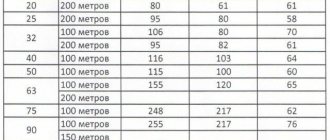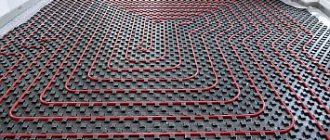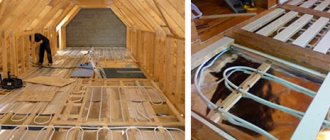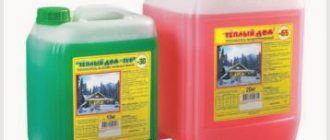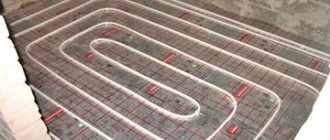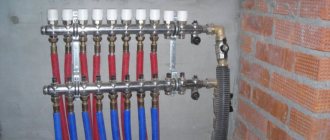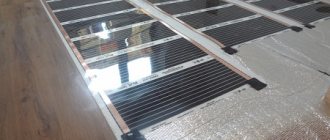If carpet will be laid on a warm floor, then a base made of wood or concrete screed will be suitable. This heating system is the optimal solution for residential premises, allowing you to obtain a comfortable floor covering. For effective heating operation, you need to choose the carpet wisely and use powerful heating elements. To install a heated floor under a carpet, it is necessary to provide for the installation of an insulating (heat-reflecting) layer. Before deciding whether or not to install a heated floor, you should consider options for heating systems under the carpet. Each of them has certain functional features and performance characteristics.
What type of device to choose
All manipulations are carried out in stages. Types of electric heated floors can be divided into three groups:
- Thermal mats. It is a mounting grid on the surface of which heating elements are fixed. The cable is used both single-core and two-core. For installation you will need a layer of tile adhesive or screed.
- Resistive. The package includes a heating cable (self-regulating), which is laid on the surface of the rough coating. Placed in a layer of screed.
- Carbon (infrared) floor. It is a thin film on the surface of which heating elements made of carbon are placed (they emit infrared rays). To achieve greater strength, the material is laminated. In this case, there is no need for a screed.
Laying scheme for carpet
Most craftsmen agree and recommend installing infrared film devices. The use is due to a number of advantages:
- high level of fire safety;
- space saving. The height of the room will remain the same, since the height of the mats used does not even reach a centimeter;
- installation work is carried out with your own hands, without involving third parties. If necessary, the material is divided into several fragments, and no screed is needed;
- the device allows you to partially heat the room;
- mats can be used in combination with any type of flooring;
- if necessary, the device is dismantled and placed in another place;
- environmental friendliness. Heat accumulates under the floor. Heat is distributed evenly, but not above human height.
There is contact! A little about compatibility
Carpet is an excellent thermal insulator and the beliefs of some skeptics are based on this axiom, who claim that heating systems under such a covering will work very poorly. The generated heat, encountering a heat insulator-carpet on the way, will go along the path of least resistance. That is, down into the subfloor or into the interfloor ceilings. In this case, it will not be your apartment that will be heated, but the room below: the neighbors’ “apartment” or even a damp, cold basement. There is a grain of truth in this opinion.
Indeed, any carpet or rug has thermal insulation properties. And to a greater extent they depend on the thickness of the material. Thin tufted carpet in its thermal insulation properties is not far from laminate on a polyethylene backing. Therefore, it is wrong to be afraid that a properly selected carpet will “eat up” all the heat. In addition, in order to reduce heat loss to the lower layers of the floor, another heat insulator is placed under the heating system during installation - usually a foil film.
Under any type of heated floor, which will subsequently be covered with carpet, a layer of heat-insulating or reflective material must be laid
Unfortunately, in order to get the same warmth on the surface of the heated carpet that you are used to feeling on the tiles, you will have to increase the temperature on the thermostat by 3-5°C. Well, the comfort that you get from a soft and at the same time warm floor is worth it!
Methods of fixing carpet
Before you start laying carpet, you need to choose one of the methods of attaching it to the base, which for this type of covering can be the following:
- fixing the whole canvas with glue and without glue;
- gluing fragments;
- stretching the canvas onto slats with nails using a special tool (stretching), in which the coating is not attached to the base at all, but is held most securely.
Depending on the chosen fastening method, the carpet is also installed. The cloth purchased in the store needs to be spread on the floor of the room so that it is smoothed and leveled for a couple of days at room temperature.
Security measures
The IR device can be safely placed under the carpet, since such systems have long been recognized as completely safe. Any installation work must be carried out step by step, following the attached instructions. To avoid possible fire and electric shock, take the following precautions:
- Give preference to automation. For such equipment, a separate electrical branch should be used. It will be necessary to install machines that will be located near the meter. An RCD is also required.
- Control block. You will need a thermostat if you plan to use carpet. It will help avoid overheating and reduce energy consumption.
- High-quality grounding. All conductive elements require separate insulation. Conductive tape will be needed to cover the entire perimeter of the film.
Stretching tension method
To fix the coating during stretching, you will need to use grippers - slats into which two rows of nails are driven at an angle of 45 degrees. To stretch the material, you will need a special device - a kicker or stretcher. In small rooms you can get by with a knee kicker, but in larger rooms you will need a more powerful tool.
With this method of laying carpet, the following stages can be distinguished:
- Preparing the base.
- Fastening grippers along the walls with the nails oriented from the center of the room.
- Laying the substrate and fastening it through 200 mm with staples.
- The smooth factory edge of the material is laid along the wall.
- The material is attached with a kicker to the gripper: having secured the teeth of the tool about a couple of centimeters from the slats, you need to strike the pillow, which fixes the carpet on the nails.
- The canvas is stretched with a powerful stretcher, starting from the corners.
- Having inserted the teeth of the stretcher into the material approximately 150 mm from the edge, they should be fixed, and then pull the ends onto the grippers using a kicker sequentially in all directions.
- The resulting excess material can be trimmed or simply folded.
- Then install skirting boards around the perimeter of the room.
If you choose the most suitable method of laying carpet for a particular room, then this floor covering will remain comfortable and neat for many years.
When decorating the premises of country houses or city apartments, carpet is increasingly used. This cozy floor covering is very practical, it is a good insulator and is pleasant to walk on even…
» data-url=»https://krutopol.com/kak-pravilno-stelit-kovrolin.html» data-image=»https://krutopol.com/wp-content/uploads/2016/08/kak-pravilno -polozhit-kovrolin2-450×313.jpg" data-title="How to lay carpet on concrete and wood floors. Installation methods using glue, tape, free fixation">
You will be interested in:
How and with what to cut carpet at home? Instructions, tips, videos
When laying carpet, it always has to be cut according to the geometry of the room so that it can lie flat and free on the floor. And this is where the proverb comes in handy...
Finishing the stairs with carpet and carpet overlays. How to choose, cut and secure the material?
In a house where there is a staircase, the question is always how to maintain its attractive appearance and functionality for as long as possible? Carpet can help you with this - with its...
Underlay for carpet on concrete and wood floors: which one is better to choose?
For those who want the flooring in their home to last for a long time without losing its attractive appearance, the solution to the question of whether a carpet underlay is needed is clear. According to experts, the substrate...
Features of laying roll coverings
After the heated floors have been laid, it’s time to think about installing the floor covering (how to install a water circuit with your own hands is described in the corresponding article).
To lay roll material, you will need to follow the following recommendations step by step:
Prepare the base - you need to level the floor to cover it with a leveling mixture. If the differences or chips are not so large, the unevenness is eliminated with putty. After drying, the surface is primed twice. When using a polystyrene system, the mats are covered with plywood or gypsum fiber board. The joints are puttied. The coating is brought into the room and left for 5-6 hours so that the material warms up to the air temperature in the room. It is strictly forbidden to lay linoleum on water-heated floors that have been brought in from the street immediately before installation. After heating to room temperature, the material is rolled out over the entire area and trimmed. The laid flooring should be approximately 0.3-0.5 cm away from the wall. The joints will subsequently be covered with skirting boards. Carpet or linoleum laid on a water-heated floor will “settle down” after about a day, and the waves will disappear. When laying over a concrete floor, it is best to glue the flooring to the surface
When choosing an adhesive composition, you should pay attention to its purpose. There are special adhesives and mastics with high elasticity that allow the material to “walk” as the surface heats up and cools down.
If the floors are covered with linoleum, without an adhesive base, and are simply pressed against the base with baseboards, waves will certainly appear over time. A special feature of carpet is that fine dust, which is attracted by the cement screed, easily passes through the pores of the material. Therefore, it is better to place it on plywood or gypsum board.
Which linoleum is better for a water floor?
Choosing linoleum for a water-heated floor can be difficult, since there is a wide variety of products that differ in both purpose and performance characteristics.
You should pay attention to the following criteria:
- Class - the optimal choice would be commercial or semi-commercial material. These classes have a high level of wear resistance, can easily withstand high temperatures and retain color and pattern during use.
- Type of material - multilayer polyvinyl chloride linoleum should be laid. It is believed that polyvinyl chloride type coating is completely safe for laying on top of heated floors. An alternative could be vinyl material. You can cover warm water floors with vinyl linoleum only if there are no allergy sufferers in the house.
- Cost – linoleum for heated floors cannot be cheap. Budget options usually quickly turn yellow, lose their pattern and shape, and are toxic.
When choosing a finishing material, you should seek help from a consultant and purchase one that is of high quality and wear resistance.
Which carpet is suitable for a water floor?
When choosing carpet for a water-heated floor, you should follow the same instructions as when purchasing suitable linoleum:
- Base – material with a thermal insulation or sound insulation backing is not recommended. The layer retains heat, leading to overheating and increased energy consumption.
- Purpose – for an apartment you should choose a carpet for a semi-commercial type of water-heated floor. Commercial flooring with high wear resistance and fine pile is installed in the office. The use of natural carpets in this case is impractical.
Under certain conditions, roll materials can be used as a finishing coating for warm water floors. In this case, you will need to comply with the rules associated with installation and safe subsequent operation.
Installation of infrared heated floors
Such structures can be installed independently. To do this, just study the step-by-step instructions supplied by the manufacturer. But first you need to purchase the necessary components, such as:
- thermostat sensor;
- additional set of wires;
- a set of infrared film, which is sold in rolls;
- To avoid possible heat loss, you will need material for a thermal insulation gasket.
Step-by-step installation scheme (including on a wooden floor):
- First, the surface to be used is prepared. Old material (if necessary), construction and other debris is removed. Severe irregularities are eliminated. It is necessary to level the surface if the level of difference exceeds several millimeters per meter of surface.
- It is recommended to use a thermal insulation layer to minimize heat losses. A non-conductive material should be used (this will improve overall safety). Construction tape is used to fasten sheets of material.
- Warm flooring is installed under the carpet. The entire surface of the room is covered with mats, with the exception of areas where furniture will be located.
- Connecting the device. To do this, connect a thermostat, which is recommended to be mounted on the wall, half a meter from the floor. Wiring is laid, the connection to which is made in parallel. This entire layer is well insulated using sealants.
- The thermostat can be installed in several ways (external and internal). You can groove the area from the floor surface to the place where it is to be installed. If the renovation of the room has already been completed, you can use a plastic box in which all the wires are conveniently placed. The sensor is mounted under the film in a small recess. After connection, the device undergoes a performance check. A working system should heat the surface in five minutes. Grounding plays an important role, so all ends of the film should be taped with special tape, which is then attached to the wire.
- Installation of the insulating layer. When using carpet, a top layer of insulation is mandatory. For this, plywood is used, which can protect infrared mats from any mechanical damage, and the carpet from overheating.
- Carpet installation. Before this, the material is rolled out throughout the room and left completely undisturbed for the day. During this time, the material will straighten on its own. Adhesive tape is used for fixation. You can only walk around the room the next day.
Is it possible to cover TP with linoleum?
TP and linoleum are completely compatible things. Experts have even developed a special technology that combines these two concepts - infrared film flooring. In order for the design to work correctly and for a long time, you need to choose the appropriate type of linoleum. First of all, it should not have a heat-insulating base, otherwise mounting the TP will be pointless. You should also choose the right linoleum with a heated floor design. Fortunately, the modern construction market offers a large amount of suitable material.
This is indicated by a special icon included in the technical data sheet of the product. If you ignore this point, you may buy the wrong linoleum flooring. As a result, under constant contact with high temperatures, formaldehyde will begin to be released from the material, which is extremely dangerous for the human body. Also, linoleum will lose its strength and will tear.
TP on wooden floor
Which linoleum to choose?
When choosing linoleum for TP, choose one that does not contain harmful substances. Experts advise buying natural coating. As practice shows, some types of linoleum are not resistant to prolonged exposure to high temperatures. This negative phenomenon occurs for several reasons.
For example, if you combine linoleum with an infrared rod floor, its heating level will be adjusted automatically, and you won’t think about it.
If you have film heating under the linoleum, then you must set a limit for it. You need to control the temperature with a special thermostat. The maximum permissible heating temperature is 30 degrees.
Also, the flooring itself must be resistant to heat. It is better to choose linoleum of medium thickness. Craftsmen recommend buying commercial-grade coating because it has a protective layer.
Room measurements and foundation preparation
Before laying the carpet correctly, you need to study the geometry of the floor: take into account all the protrusions, niches, openings and other details when cutting. All room dimensions and details are drawn on a sketch, which should be presented to the seller in the store. It will be easier for you to calculate the amount of material from it in accordance with the width of the available rolls. When choosing a particular material, you need to take into account the geometry of the room and the compatibility of standard roll sizes with the size of the room.
Before laying the covering you must:
- mark on the canvas the places of cutouts for partitions, etc.;
- add 5 cm to the total dimensions so that in case of any adjustment to the position of the piece, it will have a margin.
Combination of different types of warm floors and carpet - pros and cons
Carpet is a good thermal insulator, so it is considered that it is not suitable for heating devices, since the heat will be wasted. This is true if you lay thick carpet.
However, today tufted carpet is produced; it is thinner than the standard type, and its properties are similar to laminate or linoleum. Therefore, it is important to choose the right model of carpet (carpet) for a warm floor.
In addition, to reduce heat loss, it is necessary to lay an additional heat insulator in the form of a foil film under the heating elements.
It should be noted that to obtain a temperature on the carpet that is similar in feel to floor tiles, you will need to set the thermostat to 3 to 5 degrees higher.
But it’s worth it, since this floor covering for heated floors has a number of advantages:
- walking on warm, soft carpet is much more pleasant and comfortable;
- it will provide comfortable conditions both when the system is on and off;
- creates excellent sound insulation;
- easy to style;
- has a huge number of models, different colors and pile lengths.
It is impossible not to note the presence of shortcomings:
- Carpet is suitable for rooms where it is dry and clean;
- Requires constant cleaning;
- May cause allergies in susceptible people;
- Such coverage is not appropriate if animals live in the house;
- An excellent thermal insulator is the main disadvantage, but this can be solved if you use the right type of carpet.
Free way.
This method of flooring is considered the most economical, as it is carried out using improvised means. It has two varieties, distinguished by the method of fixation:
- Along the perimeter. This mounting option is the simplest, because the carpet is attached using a plinth. To begin with, the material is spread around the entire perimeter of the room. A prerequisite is an allowance on each side, which should be about 15 cm. The carpet is leveled from the center to the edges. This process can be carried out either with a special roller or by hand. Only after careful smoothing is the excess material cut off, and the remaining carpet is secured with skirting boards around the perimeter. In the doorway it is most often secured with a metal strip or threshold.
The advantages of this installation:
- The material can be easily dismantled if necessary and re-attached.
- The entire flooring process does not require the help of professionals, which saves a lot of money.
- No additional equipment or materials are required for fastening.
- It is not necessary to prepare the floor before starting work.
- After a long period of use, wrinkles or bubbles may form on the surface.
- This fixation method is not suitable if the room has mobile furniture equipped with roller wheels.
- Rearranging furniture may be more problematic as the covering may move.
- Careful care of the carpet will be required, since the use of washing vacuum cleaners is not recommended.
- The material should be monolithic, and the room should not be too large.
Main characteristics of water flooring
Pipes through which the coolant is supplied are distributed on the floor surface; it is best to lay them in a concrete screed; if you decide to use wooden and flooring systems, the installation process becomes much more complicated.
Advantages of a water floor:
- can heat up to 36 degrees, so it is often used as the main type of heating;
- allows efficient use of room space;
- does not dry out the air;
- does not create magnetic and electric fields.
Flaws:
- it is very difficult to install such a floor in apartments that are connected to centralized heating;
- difficult to install;
- warms up slowly.
Review of popular brands
Among the variety of models of heated floors under carpet, the following heater models deserve special attention:
- Teplolux
- Sinplain
The difference between the first warm floor under the carpet is the ability to achieve the best effect when used on the following types of floor coverings:
- Parquet
- Linoleum
- Laminate
Its design includes an installation wire up to 2.5 meters long. This type of infrared heated floor under a carpet can even work on a tiled surface. It is easy to clean, since its outer layer is made of artificial felt. It is easy to store and takes up minimal space.
The maximum permissible heating temperature for the surface of such a polo is 30° C. It is ideal to place it under pile and woven carpets. The Sinplain model is also in great demand among buyers. Its thickness reaches only 0.6 mm, but this in no way affects its performance.
Typically, the company's products are produced in standard sizes, but upon request it is possible to produce fabric of any length and width. This mobile heater goes well with almost all floor coverings.
No concrete screed is required for its installation. And to maintain a comfortable temperature in the room, it is enough for this heater to cover only one third of the floor surface.
Design features allow the manufacturer to claim that if one of the elements fails, the rest will work as usual. The presence of a regulator allows you to maintain the required temperature, while saving energy consumption.
What do experts recommend?
So, who should pay attention to mobile heated floors? Experts recommend these heaters to parents of small children. After all, they spend most of their time on the floor and can even fall asleep there
To ensure a comfortable temperature for your child, you should lay a warm floor under the carpet. And then your baby will not be afraid of a cold, and playing on the floor will bring only positive emotions.
This model will not hurt those who live in a rented apartment, where the temperature in winter is not very comfortable. A mobile heated floor will allow you to achieve warmth and comfort in the room even in the off-season. And when you move to a new apartment, you won’t have to leave it behind. It is packed in a special bag and is easy to transport.
The film heater is popular not only among summer residents, but also among city dwellers. Not all multi-storey buildings can install cable floor heating systems. Since this requires filling the cable with a cement screed with a thickness of at least 5 centimeters. And in houses with wooden flooring, it is not always possible to install cable heated floors.
And in this case, warm floors under carpets can undoubtedly solve the heating problem. If necessary, the system can be easily installed under tiles, both in the bathroom and in the kitchen. To do this, it will be enough to attach an electric heater using special glue. The installed sensor is output to the thermostat. The floor level rises by only 7 millimeters.
Conclusion
Having examined the models and design features of heated floors under carpet, you can once again be convinced of their undoubted advantage over other similar systems.
They have a lot of advantages:
- Easy to use
- Safe for children and animals
- Easy to transport
- Economical
- Able to evenly warm the air in the room
Unlike other heating systems, for example, cable ones, film heaters do not require major repairs during installation. They are easy to install and operate.
They heat up quickly and are able to maintain a certain temperature. A film heater that is placed under the carpet can also be used to heat a cold wall, placed under the mirror in the bathroom or placed near the balcony door. It is easy to move from room to room.
This heater is perfect for any room. The heat from it is well transferred both to the objects covering it and directly to the air in the room. Therefore, their purchase will be a godsend for those who love warmth and comfort.
How can carpet save you money and keep you warm in winter?
With winter approaching and utility costs rising, choosing the right rugs for your home is a great way to stay warm and save money. Floors without proper carpeting and insulation are major sources of heat loss.
How to lay a carpet correctly: preparing the base
While a good carpet is essential to keeping your home warm during the winter, it will be more effective if you take a few other important steps beforehand.
How to lay a carpet correctly: insulate your home
It's never too late to insulate your home—homes without insulation are 70% cooler than homes with insulation, and insulation can cut heating costs by 45-55%.
How to Install Carpet: Shorten the Openings
If you add up all the openings and cracks in the average house together, they are equivalent to leaving a 1 x 1.5 meter window open 24/7! Seal all holes with good quality filler or caulking and you will see a big difference.
When is it possible
Small decorative rugs near upholstered furniture are always allowed. Cloths occupying a large area on a heated floor are permissible only if they have high thermal conductivity. And even then, it is better to choose durable mats or openwork fabrics made from natural materials - synthetics will not last long.
As for mobile heated floors, they need a carpet - this is the very protection from mechanical impact. True, you should still not use options that are too dense and fluffy - with such a coating, the efficiency of the heaters is reduced, and their circuitry requires the connection of automatic thermostats. The best option is heat-resistant synthetics or natural fabrics of medium density. Let's say short pile. But it is better to avoid bright colors and patterns - it is unknown whether the dye will withstand the temperature test.
System advantages
The installation of water, electric, or any other type of heated floor is not associated with the installation of radiators above its surface.
Heated floors have the following advantages compared to conventional methods of heating rooms:
- Lack of air convection, which in turn eliminates the appearance of drafts.
- Safety . The installation of water, electric, or any other type of heated floor does not involve the installation of radiators above its surface. Therefore, children can in no way be burned by hot equipment.
- It is possible to create local heating zones (children's room, area near the bed, etc.).
- Harmony of design. Heat sources are disguised and do not spoil the appearance of the room.
Mobile mat - palace
The warm floor under the Teplolux carpet is a structure somewhat different from the film structure.
Its surface is made of artificial felt, which is durable and easy to clean. The canvas has certain dimensions and is available in two modifications: 2 by 1.5 m and 2.8 by 1.8 m. The basis of its heating filling is a thin cable in a protective hermetic sheath. The mat is connected to the power supply via a 2.5 meter installation wire. Such a mobile heated covering can be placed under woven, lint-free or pile carpets of medium thickness, the surface of which will be evenly heated to 35 degrees. The infrared heated floor under the carpet is connected to the electrical network using a universal plug suitable for any type of socket. The wire is fixed through the power box. The optimal temperature regime is maintained by a functional and convenient power regulator.
conclusions
In a private house, where there is enough space and technical capabilities to equip a “warm water floors” heating system, you can use carpeting for finishing. It is not recommended to cover all floors in the house with carpet. This will cause your heating boiler to work constantly in increased mode. Making a children's room with carpet, carpeting the living room, using a water floor, the task is real and feasible.
Source

